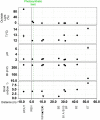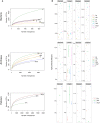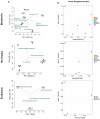Bacterial, Archaeal, and Eukaryotic Diversity across Distinct Microhabitats in an Acid Mine Drainage
- PMID: 28955322
- PMCID: PMC5600952
- DOI: 10.3389/fmicb.2017.01756
Bacterial, Archaeal, and Eukaryotic Diversity across Distinct Microhabitats in an Acid Mine Drainage
Abstract
Acid mine drainages are characterized by their low pH and the presence of dissolved toxic metallic species. Microorganisms survive in different microhabitats within the ecosystem, namely water, sediments, and biofilms. In this report, we surveyed the microbial diversity within all domains of life in the different microhabitats at Los Rueldos abandoned mercury underground mine (NW Spain), and predicted bacterial function based on community composition. Sediment samples contained higher proportions of soil bacteria (AD3, Acidobacteria), as well as Crenarchaeota and Methanomassiliicoccaceae archaea. Oxic and hypoxic biofilm samples were enriched in bacterial iron oxidizers from the genus Leptospirillum, order Acidithiobacillales, class Betaproteobacteria, and archaea from the class Thermoplasmata. Water samples were enriched in Cyanobacteria and Thermoplasmata archaea at a 3-98% of the sunlight influence, whilst Betaproteobacteria, Thermoplasmata archaea, and Micrarchaea dominated in acid water collected in total darkness. Stalactites hanging from the Fe-rich mine ceiling were dominated by the neutrophilic iron oxidizer Gallionella and other lineages that were absent in the rest of the microhabitats (e.g., Chlorobi, Chloroflexi). Eukaryotes were detected in biofilms and open-air water samples, and belonged mainly to clades SAR (Alveolata and Stramenopiles), and Opisthokonta (Fungi). Oxic and hypoxic biofilms displayed higher proportions of ciliates (Gonostomum, Oxytricha), whereas water samples were enriched in fungi (Paramicrosporidium and unknown microbial Helotiales). Predicted function through bacterial community composition suggested adaptive evolutive convergence of function in heterogeneous communities. Our study showcases a broad description of the microbial diversity across different microhabitats in the same environment and expands the knowledge on the diversity of microbial eukaryotes in AMD habitats.
Keywords: Archaea; Bacteria; Eukarya; acid mine drainage; biofilm; ore; sediment; stalactite.
Figures







Similar articles
-
Seasonal blooms of neutrophilic Betaproteobacterial Fe(II) oxidizers and Chlorobi in iron-rich coal mine drainage sediments.FEMS Microbiol Ecol. 2019 Oct 1;95(10):fiz140. doi: 10.1093/femsec/fiz140. FEMS Microbiol Ecol. 2019. PMID: 31504446
-
Biodiversity and geochemistry of an extremely acidic, low-temperature subterranean environment sustained by chemolithotrophy.Environ Microbiol. 2011 Aug;13(8):2092-104. doi: 10.1111/j.1462-2920.2011.02434.x. Epub 2011 Mar 7. Environ Microbiol. 2011. PMID: 21382147
-
Archaea dominate the microbial community in an ecosystem with low-to-moderate temperature and extreme acidity.Microbiome. 2019 Jan 28;7(1):11. doi: 10.1186/s40168-019-0623-8. Microbiome. 2019. PMID: 30691532 Free PMC article.
-
Microbial diversity and metabolic networks in acid mine drainage habitats.Front Microbiol. 2015 May 29;6:475. doi: 10.3389/fmicb.2015.00475. eCollection 2015. Front Microbiol. 2015. PMID: 26074887 Free PMC article. Review.
-
Microbial Ecology and Evolution in the Acid Mine Drainage Model System.Trends Microbiol. 2016 Jul;24(7):581-593. doi: 10.1016/j.tim.2016.03.004. Epub 2016 Apr 2. Trends Microbiol. 2016. PMID: 27050827 Review.
Cited by
-
Streptomyces Dominate the Soil Under Betula Trees That Have Naturally Colonized a Red Gypsum Landfill.Front Microbiol. 2018 Aug 3;9:1772. doi: 10.3389/fmicb.2018.01772. eCollection 2018. Front Microbiol. 2018. PMID: 30123206 Free PMC article.
-
Microbial Eukaryotes in Oil Sands Environments: Heterotrophs in the Spotlight.Microorganisms. 2019 Jun 19;7(6):178. doi: 10.3390/microorganisms7060178. Microorganisms. 2019. PMID: 31248111 Free PMC article. Review.
-
Aquatic microbial diversity associated with faecal pollution of Norwegian waterbodies characterized by 16S rRNA gene amplicon deep sequencing.Microb Biotechnol. 2019 Nov;12(6):1487-1491. doi: 10.1111/1751-7915.13461. Epub 2019 Jul 9. Microb Biotechnol. 2019. PMID: 31290258 Free PMC article.
-
Prokaryotic and eukaryotic community structure affected by the presence of an acid mine drainage from an abandoned gold mine.Extremophiles. 2018 Sep;22(5):699-711. doi: 10.1007/s00792-018-1030-y. Epub 2018 Apr 28. Extremophiles. 2018. PMID: 29705928
-
Archaeal and Extremophilic Bacteria from Different Archaeological Excavation Sites.Int J Mol Sci. 2023 Mar 14;24(6):5519. doi: 10.3390/ijms24065519. Int J Mol Sci. 2023. PMID: 36982593 Free PMC article.
References
-
- Aliaga Goltsman D. S., Denef V. J., Singer S. W., VerBerkmoes N. C., Lefsrud M., Mueller R. S., et al. (2009). Community genomic and proteomic analyses of chemoautotrophic iron-oxidizing “Leptospirillum rubarum” (Group II) and “Leptospirillum ferrodiazotrophum” (Group III) bacteria in acid mine drainage biofilms. Appl. Environ. Microbiol. 75 4599–4615. 10.1128/AEM.02943-08 - DOI - PMC - PubMed
LinkOut - more resources
Full Text Sources
Other Literature Sources
Miscellaneous

